Politics
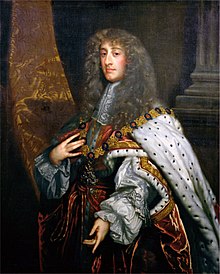 Religious beliefs have caused a number of issues in governments over the centuries, sometimes pitting family members against family members. They were, in fact, the main reason that the United States was founded…to get away from religious persecution. Such was also the case in the coup that was called Britain’s Bloodless Glorious Revolution. At the time, King James II was the king in Britain, and he was a Catholic. At first that didn’t seem like a huge problem, but King James’s policies of religious tolerance after 1685 began to meet with increasing opposition from members of leading political circles, who were troubled by the King’s Catholicism and his close ties with France. The crisis facing the King came to a head in 1688, with the birth of his son, James Francis Edward Stuart, on June 10. This changed the existing line of succession by displacing the heir presumptive, his daughter Mary, a Protestant and the wife of William of Orange, with young James Francis Edward as heir apparent, because at that time it was the first born “son” who inherited the throne. The establishment of a Roman Catholic dynasty in the kingdoms now seemed likely, and the people weren’t happy about it.
Religious beliefs have caused a number of issues in governments over the centuries, sometimes pitting family members against family members. They were, in fact, the main reason that the United States was founded…to get away from religious persecution. Such was also the case in the coup that was called Britain’s Bloodless Glorious Revolution. At the time, King James II was the king in Britain, and he was a Catholic. At first that didn’t seem like a huge problem, but King James’s policies of religious tolerance after 1685 began to meet with increasing opposition from members of leading political circles, who were troubled by the King’s Catholicism and his close ties with France. The crisis facing the King came to a head in 1688, with the birth of his son, James Francis Edward Stuart, on June 10. This changed the existing line of succession by displacing the heir presumptive, his daughter Mary, a Protestant and the wife of William of Orange, with young James Francis Edward as heir apparent, because at that time it was the first born “son” who inherited the throne. The establishment of a Roman Catholic dynasty in the kingdoms now seemed likely, and the people weren’t happy about it.
Some Tory (conservative) members of parliament worked with members of the opposition Whigs in an attempt to resolve the crisis by secretly initiating dialogue with William of Orange to come to England…outside the jurisdiction of the English Parliament. Stadtholder William, the de facto head of state of the Dutch United Provinces, feared a Catholic Anglo–French alliance and had already been planning a military intervention in England, so he was very much open to the plan. After consolidating political and financial support, William crossed the North Sea and English Channel with a large invasion fleet in November 1688, landing at Torbay in Devonshire with an army of 15,000 men, William advanced to London, meeting no opposition from James’ army, which had deserted the king. After only two minor clashes between the two opposing armies in England, and anti-Catholic riots in several towns, King James’s regime collapsed, largely because of a lack of resolve shown by the king. Following Britain’s Bloodless Glorious Revolution, Mary, the daughter of the deposed king, and William of Orange, her husband, are proclaimed joint sovereigns of Great Britain under Britain’s new Bill of Rights. At first I thought that odd, because by rights she would have been in the royal line, but I suppose you would have to honor the warrior who made it all possible.
King James was allowed to escape to France, and in February 1689 Parliament offered the crown jointly to  William and Mary, provided they accept the Bill of Rights. The Bill of Rights, which greatly limited royal power and broadened constitutional law, granted Parliament control of finances and the army and prescribed the future line of royal succession, declaring that no Roman Catholic would ever be sovereign of England. The document also stated that Englishmen possessed certain inviolable civil and political rights, a political concept that was a major influence in the composition of the United States Bill of Rights, composed almost exactly a century later. The Glorious Revolution, the ascension of William and Mary, and the acceptance of the Bill of Rights were decisive victories for Parliament in its long struggle against the crown.
William and Mary, provided they accept the Bill of Rights. The Bill of Rights, which greatly limited royal power and broadened constitutional law, granted Parliament control of finances and the army and prescribed the future line of royal succession, declaring that no Roman Catholic would ever be sovereign of England. The document also stated that Englishmen possessed certain inviolable civil and political rights, a political concept that was a major influence in the composition of the United States Bill of Rights, composed almost exactly a century later. The Glorious Revolution, the ascension of William and Mary, and the acceptance of the Bill of Rights were decisive victories for Parliament in its long struggle against the crown.
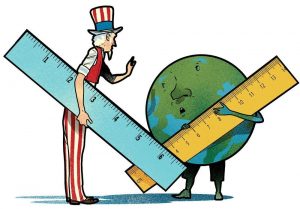 The metric system…in many ways, a source of contention between the American government, or whoever it is who keeps trying to push it on the American public, and the American public in general. Sure, it’s mixed in with our way of life, but somehow, it’s not something that most of us really understand very well. It’s like a strange foreign language, that no one wanted to learn in the first place…but somebody told us that it was important, better, more efficient…or some other such nonsense. It’s perfectly acceptable to use the metric system in the United States…in fact, Congress originally authorized its use in 1866 and has repeatedly tried to make it accepted in the years since, but the American public has continued to reject it.
The metric system…in many ways, a source of contention between the American government, or whoever it is who keeps trying to push it on the American public, and the American public in general. Sure, it’s mixed in with our way of life, but somehow, it’s not something that most of us really understand very well. It’s like a strange foreign language, that no one wanted to learn in the first place…but somebody told us that it was important, better, more efficient…or some other such nonsense. It’s perfectly acceptable to use the metric system in the United States…in fact, Congress originally authorized its use in 1866 and has repeatedly tried to make it accepted in the years since, but the American public has continued to reject it.
Although the government now requires metric use in some public sectors and strongly encourages it in many  private industries, but the American public never really took to the system and largely dismissed it, making the United States the only industrialized nation where that’s the case. These days the medical field exclusively uses it in their jobs, but when a nurse takes your temperature and tells you that it is 38° C, and you ask her how much that is in “English,” most of them have no idea that it is 101° F. Yes, they know that you are running a fever, but seriously, when you are running a fever, do you want to have to get out your nearest conversion table to figure out how high it is. Most of us know that normal is 98.6° F, but when you don’t feel good, the last thing you want to do is math. I don’t know who came up with inches and centimeters, or Celsius and Fahrenheit battle, but up until 1866, the United States knew what their measurements meant. We didn’t have to try to sit down and figure it all out. Why should we have to now? In American, it just doesn’t measure up.
private industries, but the American public never really took to the system and largely dismissed it, making the United States the only industrialized nation where that’s the case. These days the medical field exclusively uses it in their jobs, but when a nurse takes your temperature and tells you that it is 38° C, and you ask her how much that is in “English,” most of them have no idea that it is 101° F. Yes, they know that you are running a fever, but seriously, when you are running a fever, do you want to have to get out your nearest conversion table to figure out how high it is. Most of us know that normal is 98.6° F, but when you don’t feel good, the last thing you want to do is math. I don’t know who came up with inches and centimeters, or Celsius and Fahrenheit battle, but up until 1866, the United States knew what their measurements meant. We didn’t have to try to sit down and figure it all out. Why should we have to now? In American, it just doesn’t measure up.
So, in the next act of “pushiness,” Congress even passed a Metric Conversion Act of 1975 and set up a U.S.  Metric Board to take care of all the planning for the desired transition, but they apparently didn’t empower the board with enough authority, and the American people essentially said, “no” to adopting metric system, and continued on with their miles, pounds, ounces and all the rest. Similarly lackluster efforts since then have done little to get Americans to change their minds. We are a stubborn people, and we don’t really like it when someone tells us that, what we have always known as white, is now black. That simply makes no sense, and just because Congress tells us that it does, doesn’t mean that it is so. I don’t suppose that the failed metric conversion will be the last thing that Congress tries to push on us, that will end up in the junk heap…do you?
Metric Board to take care of all the planning for the desired transition, but they apparently didn’t empower the board with enough authority, and the American people essentially said, “no” to adopting metric system, and continued on with their miles, pounds, ounces and all the rest. Similarly lackluster efforts since then have done little to get Americans to change their minds. We are a stubborn people, and we don’t really like it when someone tells us that, what we have always known as white, is now black. That simply makes no sense, and just because Congress tells us that it does, doesn’t mean that it is so. I don’t suppose that the failed metric conversion will be the last thing that Congress tries to push on us, that will end up in the junk heap…do you?
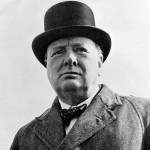 As a young battalion commander, Winston Churchill had a lot to learn about the facts of war. He was destined for greatness, and if he was to realize his destiny, he would have to learn many things. On January 17, 1916, he was battalion commander on the Western Front, when he attended a lecture on the Battle of Loos given by his friend, Colonel Tom Holland, in the Belgian town of Hazebrouck. It would be one of the first lessons, but the resulting knowledge might not be what we all would think. It was not about strategy or brave heroics, but rather of hopelessness.
As a young battalion commander, Winston Churchill had a lot to learn about the facts of war. He was destined for greatness, and if he was to realize his destiny, he would have to learn many things. On January 17, 1916, he was battalion commander on the Western Front, when he attended a lecture on the Battle of Loos given by his friend, Colonel Tom Holland, in the Belgian town of Hazebrouck. It would be one of the first lessons, but the resulting knowledge might not be what we all would think. It was not about strategy or brave heroics, but rather of hopelessness.
The Battle of Loos, which took place in September 1915, resulted in devastating casualties for the Allies and was taken by the British as a sign of the need to change their conduct of the war. In one major consequence, Sir John French was replaced by Sir Douglas Haig as British commander in the wake of that battle. “Tom spoke very well,” Churchill wrote to his wife, Clementine, “but his tale was one of hopeless failure, of sublime heroism utterly wasted and of splendid Scottish soldiers shorn away in vain with never the ghost of a chance of success. Afterwards they asked me what was the lesson of the lecture. I restrained an impulse to reply ‘Don’t do it again.’ But they will–I have no doubt.” What Churchill took away from the lecture was that in war, there is no winner…not really. There are losses on both sides, sometimes almost equal in number, so that the victory goes to the one who holds out the longest. Defeat comes in surrender.
Churchill had been demoted from First Lord of the Admiralty after the British plan to attempt a naval capture of the Turkish-controlled Dardanelle Straits met with resounding failure in mid-to-late 1915. Reduced to a minor ministerial position, Churchill resigned from the government in November 1915 and rejoined the army, heading 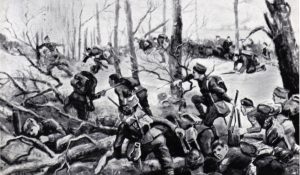 to the Western Front with the rank of lieutenant colonel. During his six months in Belgium, Churchill…who would later lead his country to victory in the World War II and be celebrated as the greatest political leader in British history, saw first-hand the hardships of war and the sacrifices that unknown, unheralded soldiers made for their country. More than once, he himself narrowly escaped death by an enemy shell. As he wrote to Clementine, “Twenty yards more to the left and no more tangles to unravel, no more anxieties to face, no more hatreds and injustices to encountera good ending to a chequered life, a final gift–unvalued–to an ungrateful country.” I find it amazing that a man so capable of “winning” a war, would count it as lost.
to the Western Front with the rank of lieutenant colonel. During his six months in Belgium, Churchill…who would later lead his country to victory in the World War II and be celebrated as the greatest political leader in British history, saw first-hand the hardships of war and the sacrifices that unknown, unheralded soldiers made for their country. More than once, he himself narrowly escaped death by an enemy shell. As he wrote to Clementine, “Twenty yards more to the left and no more tangles to unravel, no more anxieties to face, no more hatreds and injustices to encountera good ending to a chequered life, a final gift–unvalued–to an ungrateful country.” I find it amazing that a man so capable of “winning” a war, would count it as lost.
 I grew up in Casper, Wyoming in the 70’s. There wasn’t a whole lot for the teen crowd to do, so we all rode “The Strip.” The Strip included all of CY Avenue and part of Center Street and 2nd Street. Most if the kids who had access to a car or knew someone who did, were out on the Strip every Friday and Saturday night. People would show off their “ride,” if they had a cool one, and meet up with their friends. My husband, Bob Schulenberg and I had lots of good friends we hooked up with on the Strip. One of our good friends was Lana Alldredge. Lana had one of those “rides” that was one to show off…a 1970 Mustang Mach 1…Canary Yellow with black stripes. She was so proud of that car. Every night before heading out to ride the Strip, Lana took her car to the carwash for a bath, because she couldn’t stand the thought of her car being dirty when people saw it. Now Lana was out of high school, and so rode the Strip every night, while my parents wouldn’t let me go out on school nights. Nevertheless, lots of kids could go out every night,
I grew up in Casper, Wyoming in the 70’s. There wasn’t a whole lot for the teen crowd to do, so we all rode “The Strip.” The Strip included all of CY Avenue and part of Center Street and 2nd Street. Most if the kids who had access to a car or knew someone who did, were out on the Strip every Friday and Saturday night. People would show off their “ride,” if they had a cool one, and meet up with their friends. My husband, Bob Schulenberg and I had lots of good friends we hooked up with on the Strip. One of our good friends was Lana Alldredge. Lana had one of those “rides” that was one to show off…a 1970 Mustang Mach 1…Canary Yellow with black stripes. She was so proud of that car. Every night before heading out to ride the Strip, Lana took her car to the carwash for a bath, because she couldn’t stand the thought of her car being dirty when people saw it. Now Lana was out of high school, and so rode the Strip every night, while my parents wouldn’t let me go out on school nights. Nevertheless, lots of kids could go out every night, 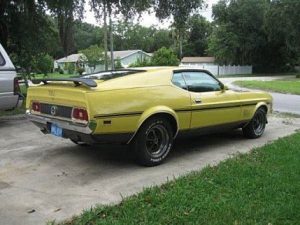 so her car was one that was well known, and had the reputation of always being clean, shiny, and tricked out. If you rode the Strip, you knew Lana’s car.
so her car was one that was well known, and had the reputation of always being clean, shiny, and tricked out. If you rode the Strip, you knew Lana’s car.
I read somewhere that in Minnetonka, Minnesota, there is a law, currently on the books that would work well for Lana, but not so much for most people. According to section 845.110 of Minnetonka, Minnesota’s city laws, there are several situations that are deemed a “public nuisance”, including but certainly not limited to ” a truck or other vehicle whose wheels or tires deposit mud, dirt, sticky substances, litter or other material on any street or highway“. Now, if you ask me, that is extreme. The only way to never have dirty tires is pretty much to bathe your vehicle constantly. While someone like Lana would be ok with that in her Mach 1 years, most people can’t see the point in a daily car bath, just so they didn’t get dirt on the street…in fact, the law is simply, outrageously insane, if you ask me.
 I agree with city beautification, and I can see not wanting the citizens throw shovel loads of dirt or mud onto the city streets, but lets face it…the wind probably deposits more, dirt and litter that the car tires do. Dirty tires, seem more like a relatively unavoidable consequence, rather than considering it a public nuisance, which is defined as something that disturbs peace, safety, and/or general welfare. Dirty tires are a little bit of a stretch here. On the other hand, there really aren’t many things that are less appealing than a dirty truck, especially when it has dirty tires, so maybe this law was founded on some good principles. Still, if this is a law that is still enforced, I don’t think I would want to live in Minnetonka, Minnesota.
I agree with city beautification, and I can see not wanting the citizens throw shovel loads of dirt or mud onto the city streets, but lets face it…the wind probably deposits more, dirt and litter that the car tires do. Dirty tires, seem more like a relatively unavoidable consequence, rather than considering it a public nuisance, which is defined as something that disturbs peace, safety, and/or general welfare. Dirty tires are a little bit of a stretch here. On the other hand, there really aren’t many things that are less appealing than a dirty truck, especially when it has dirty tires, so maybe this law was founded on some good principles. Still, if this is a law that is still enforced, I don’t think I would want to live in Minnetonka, Minnesota.

 The process of trying to end a war and bring peace between nations is a tricky one, and one that can end up being highly volatile, or even explode into further fighting!! The world was in the midst of World War I, and an armistice had been signed between Russia and Germany. The Soviet government had requested peace negotiations on Nov. 8, 1917. They began on December 22, 1917, nearly three weeks after a ceasefire was declared on the Eastern Front. Representatives of the two countries began peace negotiations at Brest-Litovsk, near the Polish border in what is now the city of Brest, in Belarus. They were divided into several sessions. During this time, the Soviet delegation tried to prolong the proceedings, so they could take full advantage of the opportunity to issue propaganda statements. Meanwhile, the Germans grew increasingly impatient with the delays.
The process of trying to end a war and bring peace between nations is a tricky one, and one that can end up being highly volatile, or even explode into further fighting!! The world was in the midst of World War I, and an armistice had been signed between Russia and Germany. The Soviet government had requested peace negotiations on Nov. 8, 1917. They began on December 22, 1917, nearly three weeks after a ceasefire was declared on the Eastern Front. Representatives of the two countries began peace negotiations at Brest-Litovsk, near the Polish border in what is now the city of Brest, in Belarus. They were divided into several sessions. During this time, the Soviet delegation tried to prolong the proceedings, so they could take full advantage of the opportunity to issue propaganda statements. Meanwhile, the Germans grew increasingly impatient with the delays.
The leader of the Russian delegation was Leon Trotsky, the Bolshevik People’s Commissar for Foreign Relations. Max Hoffmann, the commander of German forces on the Eastern Front, served as one of the chief negotiators on the German side. The main difference of opinion in Brest-Litovsk was over the surrender of Russian land to the Germans. The Russians demanded a peace agreement without annexations or indemnities and the Germans were unwilling to concede on this point. In February 1918, Trotsky announced he was withdrawing the Russians from the peace talks, and the war was on again. This would turn out to be one of the biggest, if no the biggest mistake of his career.
With the renewal of fighting, the Central Powers quickly took the upper hand. In a way, it was Russia against the world, and Russia was not likely to win that one. The Central Powers quickly seized control of most of Ukraine and Belarus. The Bolshevik hope that the workers of Germany and Austria, offended by their governments’ obvious territorial ambition, would rise up in rebellion in the name of the international working class people, soon vanished. Russia was fighting a losing battle, and they would have to surrender in the end.
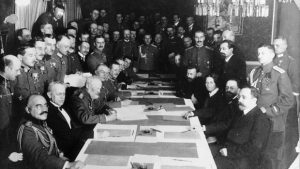
The end came on March 3, 1918, when Russia accepted peace terms that were even more harsh than those originally suggested by Germany. Russia would lose Poland, Lithuania, and the Baltic states of Estonia, Livonia, and Courland to Germany. To further devastate Russia’s hopes, Finland and the Ukraine saw Russia’s weakness as an opportunity to declare their independence. In all, Brest-Litovsk deprived Lenin’s new state of one million square miles of territory and one-third of its population, about 55 million people. Sometimes, it’s better to settle, rather than risk a loss far more devastating.
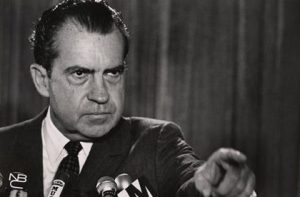 On December 13, 1972, peace talks with North Vietnam broke down, and President Richard Nixon announced that the United States will begin a massive bombing campaign to break the stalemate. Nixon was furious, and order the plans drawn up for retaliatory bombings of North Vietnam, and Linebacker II was the result. The bombings began on December 18, 1972 and continued until December 29, 1972. Beginning with American B-52s and fighter-bombers dropping over 20,000 tons of bombs on the cities of Hanoi and Haiphong. The United States lost 15 of its giant B-52s and 11 other aircraft during the attacks. North Vietnam claimed that over 1,600 civilians were killed. After eleven days of the massive pounding, the North Vietnamese agreed to resume the talks.
On December 13, 1972, peace talks with North Vietnam broke down, and President Richard Nixon announced that the United States will begin a massive bombing campaign to break the stalemate. Nixon was furious, and order the plans drawn up for retaliatory bombings of North Vietnam, and Linebacker II was the result. The bombings began on December 18, 1972 and continued until December 29, 1972. Beginning with American B-52s and fighter-bombers dropping over 20,000 tons of bombs on the cities of Hanoi and Haiphong. The United States lost 15 of its giant B-52s and 11 other aircraft during the attacks. North Vietnam claimed that over 1,600 civilians were killed. After eleven days of the massive pounding, the North Vietnamese agreed to resume the talks.
A few weeks later, the treaty was finally signed and the Vietnam War ended. This also ended the United States’ role in a conflict that seriously damaged the domestic Cold War consensus among the American public. The 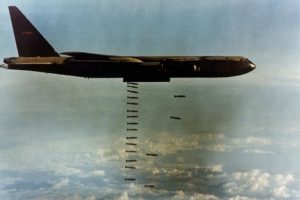 impact of the so-called “Christmas Bombings” on the final agreement remains a question. Some historians have argued that the bombings forced the North Vietnamese back to the negotiating table. Others thought that the attacks had little impact, other than the additional death and destruction they caused. Even the chief United States negotiator, Henry Kissinger, was reported to have said, “We bombed the North Vietnamese into accepting our concessions.” The chief impact may have been in convincing America’s South Vietnamese allies, who were highly suspicious of the draft treaty worked out in October 1972, that the United States would not desert them. Despite the forced return to the table, the final treaty did not include any important changes from the October draft.
impact of the so-called “Christmas Bombings” on the final agreement remains a question. Some historians have argued that the bombings forced the North Vietnamese back to the negotiating table. Others thought that the attacks had little impact, other than the additional death and destruction they caused. Even the chief United States negotiator, Henry Kissinger, was reported to have said, “We bombed the North Vietnamese into accepting our concessions.” The chief impact may have been in convincing America’s South Vietnamese allies, who were highly suspicious of the draft treaty worked out in October 1972, that the United States would not desert them. Despite the forced return to the table, the final treaty did not include any important changes from the October draft.
I believe that the bombings were instrumental in bringing the North Vietnamese back to the table, but I sometimes wonder what the emotional impact was on the men involved in the bombings. It’s hard to wage war  at anytime, but when you think of the Christmas season, and all it stands for, I must have been terribly hard to drop those bombs and end the lives of so many on what should have been a joyous holiday. I’m sure the men thought of their own families and children too. Of course, I don’t know what the North Vietnamese did about Christmas, or if it was anything to them at all, but it was to our men, and it seems to me that it would be very hard to take lives on that day…especially when, in times past it seems like it was common practice to have a cease fire on that day, but then I guess that can’t always be the case. Someone somewhere would insist on breaking the day of peace, because that is what war is all about, after all.
at anytime, but when you think of the Christmas season, and all it stands for, I must have been terribly hard to drop those bombs and end the lives of so many on what should have been a joyous holiday. I’m sure the men thought of their own families and children too. Of course, I don’t know what the North Vietnamese did about Christmas, or if it was anything to them at all, but it was to our men, and it seems to me that it would be very hard to take lives on that day…especially when, in times past it seems like it was common practice to have a cease fire on that day, but then I guess that can’t always be the case. Someone somewhere would insist on breaking the day of peace, because that is what war is all about, after all.
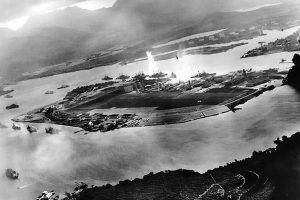
 It doesn’t matter how many years have gone by since that horrible December day 76 years ago today, I don’t think that anyone who knows anything about the attack on Pearl Harbor can forget just how horrific it was. I suppose they should have known that an attack was imminent, or at the very least suspected it. Diplomatic negotiations with Japan had broken down, and President Franklin D. Roosevelt and his advisers knew that an imminent Japanese attack was probable. Still, nothing had been done to increase security at the important naval base at Pearl Harbor. It was critical mistake that would cost a total of 2,400 Americans their lives. In addition, 1,200 were wounded, many while valiantly attempting to defend Pearl Harbor from the attack.
It doesn’t matter how many years have gone by since that horrible December day 76 years ago today, I don’t think that anyone who knows anything about the attack on Pearl Harbor can forget just how horrific it was. I suppose they should have known that an attack was imminent, or at the very least suspected it. Diplomatic negotiations with Japan had broken down, and President Franklin D. Roosevelt and his advisers knew that an imminent Japanese attack was probable. Still, nothing had been done to increase security at the important naval base at Pearl Harbor. It was critical mistake that would cost a total of 2,400 Americans their lives. In addition, 1,200 were wounded, many while valiantly attempting to defend Pearl Harbor from the attack.
It was Sunday morning, and many military personnel had been given passes to attend religious services off base. It should have been a quiet, peaceful, relaxing day. At 7:02am, two radar operators spotted large groups of aircraft in flight toward the island from the north. With a flight of B-17s expected from the United States at the time, they were told to sound no alarm. They were told wrong. At 7:55am Hawaii time, the peaceful day was shattered when, a Japanese dive bomber bearing the red symbol of the Rising Sun of Japan on its wings appeared out of the clouds above the island of Oahu. A swarm of 360 Japanese warplanes followed, descending on the United States naval base at Pearl Harbor. It was a ferocious assault. The surprise attack struck a critical blow against the United States Pacific fleet and drew the United States into World War II…like it or not. The Japanese air assault came as a devastating surprise to the naval base. Much of the Pacific fleet was rendered useless. There was simply no time to act. The window of opportunity for them to act was missed when no warning was given. Five of eight battleships, three destroyers, and seven other ships were sunk or severely damaged, and more than 200 aircraft were destroyed. Japan’s losses were some 30 planes, five midget submarines, and fewer than 100 men, and many of these were intentional suicide bombers. Fortunately for the United States, all three Pacific fleet carriers were out at sea on training maneuvers. These giant aircraft carriers would have their revenge against Japan six months later at the Battle of Midway, in a battle that would reverse the tide against the previously invincible Japanese navy in a spectacular victory.
The day after Pearl Harbor was bombed, President Roosevelt appeared before a joint session of Congress and declared, “Yesterday, December 7, 1941…a date which will live in infamy…the United States of America was suddenly and deliberately attacked by naval and air forces of the Empire of Japan.” After a brief and forceful speech, he asked Congress to approve a resolution recognizing the state of war between the United States and Japan. Finally, the president had taken action. The Senate voted for war against Japan by 82 to 0, and the House of Representatives approved the resolution by a vote of 388 to 1. The sole dissenter was Representative Jeannette Rankin of Montana, a devout pacifist who had also cast a dissenting vote against the United States 
 entrance into World War I. Three days later, Germany and Italy declared war against the United States, and the United States government responded in kind. The American contribution to the successful Allied war effort spanned four long years and cost more than 400,000 American lives. The attack on Pearl Harbor was a vicious attack that shows us that in a war, neutrality is not a guarantee of safety, but is rather viewed as a sign of weakness.
entrance into World War I. Three days later, Germany and Italy declared war against the United States, and the United States government responded in kind. The American contribution to the successful Allied war effort spanned four long years and cost more than 400,000 American lives. The attack on Pearl Harbor was a vicious attack that shows us that in a war, neutrality is not a guarantee of safety, but is rather viewed as a sign of weakness.
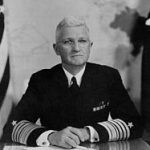
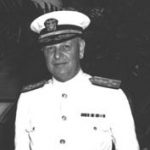 November 25, 1941, while not the date that would live in infamy, is a date that, in some ways, lives in infamy too. It was on this day that Admiral Harold R. Stark, United States Chief of Naval Operations, told Admiral Husband E. Kimmell, commander of the United States Pacific Fleet at Pearl Harbor, that both President Roosevelt and Secretary of State Cordell Hull thought that a Japanese surprise attack is a distinct possibility. It was their thought that the attack might possibly happen on the following Monday, because the Japanese were notorious for attacking without warning, President Franklin D. Roosevelt had informed his Cabinet. “We must all prepare for trouble, possibly soon,” he telegraphed British Prime Minister Winston Churchill.
November 25, 1941, while not the date that would live in infamy, is a date that, in some ways, lives in infamy too. It was on this day that Admiral Harold R. Stark, United States Chief of Naval Operations, told Admiral Husband E. Kimmell, commander of the United States Pacific Fleet at Pearl Harbor, that both President Roosevelt and Secretary of State Cordell Hull thought that a Japanese surprise attack is a distinct possibility. It was their thought that the attack might possibly happen on the following Monday, because the Japanese were notorious for attacking without warning, President Franklin D. Roosevelt had informed his Cabinet. “We must all prepare for trouble, possibly soon,” he telegraphed British Prime Minister Winston Churchill.
Kimmel’s command was at the mid-Pacific base at Oahu, which included, Pearl Harbor. At the time he received the “warning” from Stark, he was negotiating with Army Lieutenant General Walter C. Short, commander of all United States forces at Pearl Harbor, about sending United States warships out from Pearl Harbor in order to reinforce Wake and Midway Islands, along with the Philippines, which were considered possible Japanese targets. But the Army had no anti aircraft artillery to spare. War worries struck due to an intercepted Japanese diplomatic message, which gave November 25 as a deadline of sorts. If Japanese diplomacy had failed to convince the Americans to revoke the economic sanctions against Japan, “things will automatically begin to happen,” the message related. Those “things” were becoming obvious, in the form of Japanese troop movements off Formosa (Taiwan), toward Malaya. In reality, they were headed for Pearl Harbor, as was the Japanese First Air Fleet, but no one had guessed that was the intended target.
Despite the fact that so many in positions of command anticipated a Japanese attack, they had all failed to figure out that Hawaii was the target. When the attack came, they were all taken by complete and deadly surprise. Maybe they should have known, especially given the failure of diplomacy, when Japan refused United States demands to withdraw from both the Axis pact and occupied territories in China and Indochina, but no 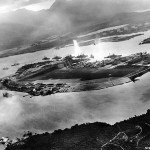
 one guessed Pearl Harbor was the target. Unfortunately they assumed Midway or Wake islands, because they seemed to be more strategic targets, and they expected that Japan would need those locations to have a chance at victory. I don’t know why the Japanese decided on Pearl Harbor, but perhaps it was a way of attacking in the heart of the United States…or as much as they felt they could. Whatever the case may be, the United States came back with a vengeance, and the Japanese would regret their attack on Pearl Harbor, because they would lose the war, date that would live in infamy…or not.
one guessed Pearl Harbor was the target. Unfortunately they assumed Midway or Wake islands, because they seemed to be more strategic targets, and they expected that Japan would need those locations to have a chance at victory. I don’t know why the Japanese decided on Pearl Harbor, but perhaps it was a way of attacking in the heart of the United States…or as much as they felt they could. Whatever the case may be, the United States came back with a vengeance, and the Japanese would regret their attack on Pearl Harbor, because they would lose the war, date that would live in infamy…or not.
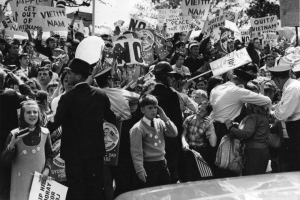 The Vietnam War…often thought of as the one America lost, was an unpopular war, as most people know. Protests were everywhere, and some young men ran away to Canada to avoid going to war. Our soldiers were hated, mocked, and protested…especially when they came home from the war. People didn’t line up at airports to welcome them home, they lined up to protest them…calling them “baby killers” and spitting on them. Although such incidents were rare, the stories were often repeated among US soldiers in Vietnam. These stories added to the soldiers’ resentment of the antiwar movement. Rather than being greeted with anger and hostility, however, most Vietnam veterans received very little reaction when they returned home. They mainly noticed that people seemed uncomfortable around them and did not want to talk about their wartime experiences. “Society as a whole was certainly unable and unwilling to receive these men with the support and understanding they needed,” Christian G Appy explains in his book Working-Class War: American Combat Soldiers and Vietnam, “The most common experiences of rejection were not explicit acts of hostility but quieter, sometimes more devastating forms of withdrawal, suspicion, and indifference.” There was no tickertape parade to welcome home the heroes…nothing!! The veterans, who were just following orders, doing their duty, were blamed for the decisions of the government to go to war. It doesn’t matter to me whether this war was unnecessary, a lost cause, or a war we should or should not have been in, the soldiers should never have been blames for it. For years after the war, the Vietnam Veterans were shunned, neglected, and ridiculed.
The Vietnam War…often thought of as the one America lost, was an unpopular war, as most people know. Protests were everywhere, and some young men ran away to Canada to avoid going to war. Our soldiers were hated, mocked, and protested…especially when they came home from the war. People didn’t line up at airports to welcome them home, they lined up to protest them…calling them “baby killers” and spitting on them. Although such incidents were rare, the stories were often repeated among US soldiers in Vietnam. These stories added to the soldiers’ resentment of the antiwar movement. Rather than being greeted with anger and hostility, however, most Vietnam veterans received very little reaction when they returned home. They mainly noticed that people seemed uncomfortable around them and did not want to talk about their wartime experiences. “Society as a whole was certainly unable and unwilling to receive these men with the support and understanding they needed,” Christian G Appy explains in his book Working-Class War: American Combat Soldiers and Vietnam, “The most common experiences of rejection were not explicit acts of hostility but quieter, sometimes more devastating forms of withdrawal, suspicion, and indifference.” There was no tickertape parade to welcome home the heroes…nothing!! The veterans, who were just following orders, doing their duty, were blamed for the decisions of the government to go to war. It doesn’t matter to me whether this war was unnecessary, a lost cause, or a war we should or should not have been in, the soldiers should never have been blames for it. For years after the war, the Vietnam Veterans were shunned, neglected, and ridiculed.
By the 1980s, however, many Americans began to change their views of Vietnam veterans. They began to see that even if the war was wrong, most of the men who fought it were just ordinary guys doing their jobs. Many 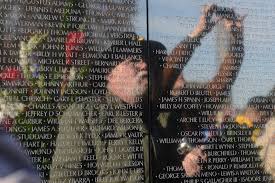 people started to feel sympathy and even gratitude toward the veterans. Soldiers who had served in Vietnam finally began receiving recognition and were honored by marching in holiday parades across the country. In 1985, Newsweek reported that “America’s Vietnam veterans, once viewed with a mixture of indifference and outright hostility by their countrymen, are now widely regarded as national heroes.” People had finally begun to understand how wrong they had been to blame the veterans for the war. Many people felt remorse for the horrible way this returning heroes were treated. Those who had this change of heart, began to do what they could to make amends. Better late than never, I guess, but in reality, no veteran should ever be treated that way.
people started to feel sympathy and even gratitude toward the veterans. Soldiers who had served in Vietnam finally began receiving recognition and were honored by marching in holiday parades across the country. In 1985, Newsweek reported that “America’s Vietnam veterans, once viewed with a mixture of indifference and outright hostility by their countrymen, are now widely regarded as national heroes.” People had finally begun to understand how wrong they had been to blame the veterans for the war. Many people felt remorse for the horrible way this returning heroes were treated. Those who had this change of heart, began to do what they could to make amends. Better late than never, I guess, but in reality, no veteran should ever be treated that way.
On November 13, 1982, near the end of a weeklong national salute to the American who fought in the Vietnam War, the Vietnam Veterans Memorial was dedicated in Washington after a march to its site by thousands of veterans of the conflict. The long-awaited memorial was a simple V-shaped black-granite wall inscribed with the names of the 57,939 Americans who died in the conflict, arranged in order of death, not rank, as was common in other memorials. The designer of the memorial was Maya Lin, a Yale University architecture student who entered a nationwide competition to create a design for the monument. Lin was born in Ohio in 1959, the daughter of Chinese immigrants. Many veterans’ groups were opposed to Lin’s winning design, which lacked a standard memorial’s heroic statues and stirring words. However, a remarkable shift in public opinion occurred 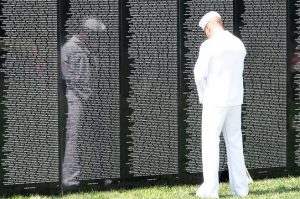 in the months after the memorial’s dedication. Veterans and families of the dead walked the black reflective wall, seeking the names of their loved ones killed in the conflict. Once the name was located, visitors often made an etching or left a private offering, from notes and flowers to dog tags and cans of beer. The Vietnam Veterans Memorial soon became one of the most visited memorials in the nation’s capital. A Smithsonian Institution director called it “a community of feelings, almost a sacred precinct,” and a veteran declared that “it’s the parade we never got.” “The Wall” drew together both those who fought and those who marched against the war and served to promote national healing a decade after the division the conflict had caused.
in the months after the memorial’s dedication. Veterans and families of the dead walked the black reflective wall, seeking the names of their loved ones killed in the conflict. Once the name was located, visitors often made an etching or left a private offering, from notes and flowers to dog tags and cans of beer. The Vietnam Veterans Memorial soon became one of the most visited memorials in the nation’s capital. A Smithsonian Institution director called it “a community of feelings, almost a sacred precinct,” and a veteran declared that “it’s the parade we never got.” “The Wall” drew together both those who fought and those who marched against the war and served to promote national healing a decade after the division the conflict had caused.

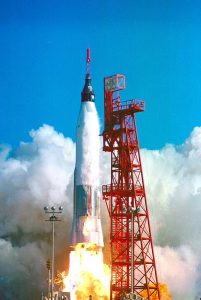 I’m sure that many of you remember the movie, Deep Impact, which was about a group of astronauts trying to save the world by deflecting a meteor, so it wouldn’t hit the earth. Robert Duvall played the part of Captain Spurgeon “Fish” Tanner, a retired, and largely considered by the rest of the crew, an “over the hill” astronaut. Nevertheless, in the end, they were glad they had him when it came to completing their mission, even though it did cost them their lives. Of course, the movie was fictional, and not realistic in many aspects, but the part that struck me as cool, was that the retired astronaut got a second chance to be useful in an important mission.
I’m sure that many of you remember the movie, Deep Impact, which was about a group of astronauts trying to save the world by deflecting a meteor, so it wouldn’t hit the earth. Robert Duvall played the part of Captain Spurgeon “Fish” Tanner, a retired, and largely considered by the rest of the crew, an “over the hill” astronaut. Nevertheless, in the end, they were glad they had him when it came to completing their mission, even though it did cost them their lives. Of course, the movie was fictional, and not realistic in many aspects, but the part that struck me as cool, was that the retired astronaut got a second chance to be useful in an important mission.
However, Captain Spurgeon Tanner wasn’t the only retired astronaut to get a second chance to go into space. On October 29, 1998, nearly four decades after he became the first American to orbit the Earth, Senator John Hershel Glenn Jr was launched into space again as a payload specialist aboard the space shuttle Discovery. At 77 years of age, Glenn was the oldest human ever to travel in space. During the nine day mission, he served as part of a NASA study on health problems associated with aging. Like our fictional Captain Spurgeon Tanner, Senator John Glenn was useful in space again. He had something that the other astronauts didn’t have…age. I don’t suppose that the studies done on John Glenn were the saving the world type, but they were real life studies, and that’s important too.
John Glenn became famous when he was chosen by NASA in 1959, along with six other men, to be the first American astronauts. He was a lieutenant colonel in the US Marine Corps. A decorated pilot, he flew nearly 150 combat missions during World War II and the Korean War. In 1957, he made the first nonstop supersonic flight across the United States, flying from Los Angeles to New York in three hours and 23 minutes. Then, in April 1961, the American space program suffered a setback of sorts, when Soviet cosmonaut Yuri Gagarin became the first man in space, and his spacecraft, Vostok 1, made a full orbit before returning to Earth. It was a feat that the United States had hoped to achieve first. The United States kicked things into high gear, and less than one month later, American Alan Shepard Jr became the first American in space when his Freedom 7 spacecraft was launched on a suborbital flight. American “Gus” Grissom made another suborbital flight in July. Then, in August, Soviet cosmonaut Gherman Titov spent more than 25 hours in space aboard Vostok 2, making 17 orbits. As a technological power, the United States looked second-rate, compared with its Cold War adversary.
If the Americans wanted to dispel this notion, they needed a multi-orbital flight before another Soviet space advance arrived. On February 20, 1962, NASA and Colonel John Glenn accomplished this feat with the flight of Friendship 7, a spacecraft that made three orbits of the Earth in five hours. Glenn was hailed as a national hero, and on February 23 President John F. Kennedy visited him at Cape Canaveral. Glenn later addressed Congress and was given a ticker-tape parade in New York City. It was at this point that NASA made the unfortunate decision not to risk the life of the now famous Glenn by sending him into space again. NASA essentially grounded the “Clean Marine” in the years after his historic flight. Frustrated with this uncharacteristic lack of activity, Glenn turned to politics, In 1964, he announced his candidacy for the US Senate from his home state of Ohio and formally left NASA. Later that year, however, he withdrew his Senate bid after seriously injuring his inner ear in a fall from a horse. In 1970, following a stint as a Royal Crown Cola executive, he ran for the Senate again but lost the Democratic nomination to Howard Metzenbaum. Four years later, he defeated Metzenbaum, won the general election, and went on to win re-election three times. In 1984, he unsuccessfully sought the Democratic nomination for president.

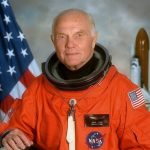
His really big claim to fame would once again come from NASA, which seemed to be his destiny after all. In 1998, Glenn attracted considerable media attention when he returned to space aboard the space shuttle Discovery. In 1999, he retired from his US Senate seat after four consecutive terms in office, a record for the state of Ohio. While his years in politics were much longer, he will always be remembered for the two historic flights he made into space.

